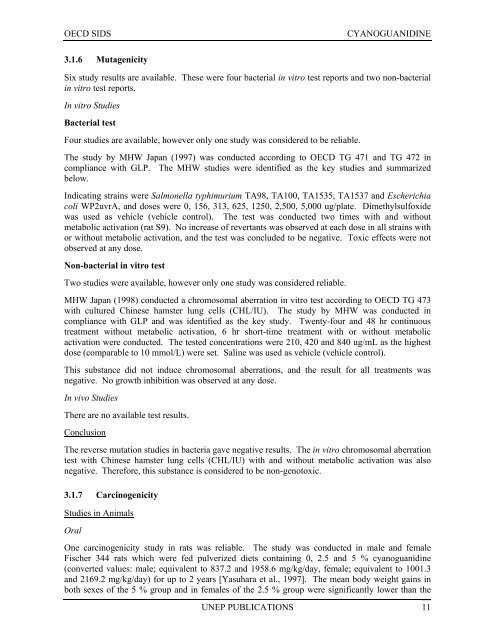Cyanoguanidine CAS N°: 461-58-5
Cyanoguanidine CAS N°: 461-58-5
Cyanoguanidine CAS N°: 461-58-5
Create successful ePaper yourself
Turn your PDF publications into a flip-book with our unique Google optimized e-Paper software.
OECD SIDS<br />
CYANOGUANIDINE<br />
3.1.6 Mutagenicity<br />
Six study results are available. These were four bacterial in vitro test reports and two non-bacterial<br />
in vitro test reports.<br />
In vitro Studies<br />
Bacterial test<br />
Four studies are available, however only one study was considered to be reliable.<br />
The study by MHW Japan (1997) was conducted according to OECD TG 471 and TG 472 in<br />
compliance with GLP. The MHW studies were identified as the key studies and summarized<br />
below.<br />
Indicating strains were Salmonella typhimurium TA98, TA100, TA1535, TA1537 and Escherichia<br />
coli WP2uvrA, and doses were 0, 156, 313, 625, 1250, 2,500, 5,000 ug/plate. Dimethylsulfoxide<br />
was used as vehicle (vehicle control). The test was conducted two times with and without<br />
metabolic activation (rat S9). No increase of revertants was observed at each dose in all strains with<br />
or without metabolic activation, and the test was concluded to be negative. Toxic effects were not<br />
observed at any dose.<br />
Non-bacterial in vitro test<br />
Two studies were available, however only one study was considered reliable.<br />
MHW Japan (1998) conducted a chromosomal aberration in vitro test according to OECD TG 473<br />
with cultured Chinese hamster lung cells (CHL/IU). The study by MHW was conducted in<br />
compliance with GLP and was identified as the key study. Twenty-four and 48 hr continuous<br />
treatment without metabolic activation, 6 hr short-time treatment with or without metabolic<br />
activation were conducted. The tested concentrations were 210, 420 and 840 ug/mL as the highest<br />
dose (comparable to 10 mmol/L) were set. Saline was used as vehicle (vehicle control).<br />
This substance did not induce chromosomal aberrations, and the result for all treatments was<br />
negative. No growth inhibition was observed at any dose.<br />
In vivo Studies<br />
There are no available test results.<br />
Conclusion<br />
The reverse mutation studies in bacteria gave negative results. The in vitro chromosomal aberration<br />
test with Chinese hamster lung cells (CHL/IU) with and without metabolic activation was also<br />
negative. Therefore, this substance is considered to be non-genotoxic.<br />
3.1.7 Carcinogenicity<br />
Studies in Animals<br />
Oral<br />
One carcinogenicity study in rats was reliable. The study was conducted in male and female<br />
Fischer 344 rats which were fed pulverized diets containing 0, 2.5 and 5 % cyanoguanidine<br />
(converted values: male; equivalent to 837.2 and 19<strong>58</strong>.6 mg/kg/day, female; equivalent to 1001.3<br />
and 2169.2 mg/kg/day) for up to 2 years [Yasuhara et al., 1997]. The mean body weight gains in<br />
both sexes of the 5 % group and in females of the 2.5 % group were significantly lower than the<br />
UNEP PUBLICATIONS 11
















